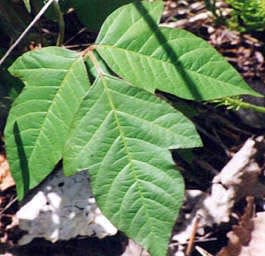Poison ivy has a lot of looks, but follow this one rule to be safe
I have to admit I have been remiss with respect to some topics. In most cases it was because I wrongly assumed some things were so widespread and common that any column of that type would simply be “preaching to the choir.”
That was my bad, and I humbly apologize. And I also promise that, in the future, I will not let any “common” topics of interest go unnoticed for long in this print space. (All readers comments on any “common” topics are welcome.)
The topic that really caught my attention came from Conrad H. in an email. He was wondering what poison ivy looked like.

He sent along a photo of a brushy area that contained several plant species, including common briers and poison ivy.
Poison ivy, as many people know, is a very common noxious plant. It is one of three similar plant species, the others being poison oak and poison sumac. The latter two are uncommon in NY and the northeastern U.S.
Some experts claim there are two or three species of poison ivy, but their “differences” are very difficult to see or describe, so I will limit this article to poison ivy as we lay people might see it.

This plant can grow differently in different areas. I have observed it growing as a small plant, both small and large climbing vines, and stand alone shrubs of various sizes. The leaves can be oval or egg shaped.
They can have smooth edges, but they can also have “notches.” The leaves can be very small (especially in young plants or sprouts from an underground root), and they can also be four to five inches long.
But there is one rule that, if followed religiously, will never steer you wrong with this unwelcome plant. It is “Leaves of three, leave it be.”
Debate: Gray wolves introduced to new habitat and the impact on elk populations
For subscribers: Resist the urge to help and leave newborn wildlife alone
For subscribers: New threat of serious illness from deer ticks popping up in an eastern state
I have seen poison ivy in many, many different places from swamps to high eastern mountains, and that three-leaf rule has always held true.
Even when there is a large “bunch” of ivy this plant rule still applies. There may be hundreds of leaf stalks coming out of vines in the bunch, but every single leaf stalk (including the individual leaf stalks and the parent vine, both of which are also infectious) will have only three leaves.
And those leaves may be the size of a half dollar, or they may be as big as an adult male’s hand. More importantly, and regardless of leaf size, all of the leaves have the same chemical toxins that can cause infection and rash. And many people who are sensitive to the toxin could suffer far worse symptoms, including hospitalizations.
I have also observed it growing in large, unbroken patches where it appears to be the only leafy plant present. And I have found it growing around the base of trees that are out in the middle of fields and well away from any wooded areas. Being cautious around this plant is wise advice.
There is a general belief that up to 350,000 people in the U.S. are adversely affected by the toxins in poison ivy annually. But that figure is downright laughable.
What the folks making such predictions probably mean is that the number mentioned may refer to the number of individuals requiring hospitalization from poisoning. There are an estimated 4.5 million individuals that contact adversely with this plant annually.
But, only the number of cases requiring hospitalization is reported. The rest rely on calamine lotion or other topical over-the-counter medications to find relief.
There is no hard and fast rules when dealing with this noxious plant. With the exception of the “Leaves of Three” rule it is the hiker/farmer/gardener/child/other outdoor activity persons who can become victims, often without even realizing they brushed by the plant in their travels.
The coverage of poison ivy in this column is “bare bones” with respect to other, more detailed and available information. And there are many photographs on the internet that can give readers better details with respect to what it looks like.
Please access any available information to educate yourselves if you do not already know what it looks like and how to avoid running into it (literally). Oh, and thanks, Conrad H., for your timely inquiry.
When poison ivy helps serve justice
This article brings back a ton of memories about my time in service as a Special Agent with the U.S. Fish and Wildlife Service, Division of Law Enforcement. Like the time I found three dove hunters hiding in a patch of standing corn.
I spotted them from across a big, recently harvested corn field. The doves were pouring into that New York farm field, which is why I stopped my vehicle in the first place. I had never seen that many doves all going in the same direction.
It was a balmy warm day, and I was just about to continue on my way when I heard a flurry of gunfire coming from somewhere on the other side of that field. So naturally I just had to find out why someone was doing all that shooting.
I found a place to hide my vehicle, then I began walking just inside a woodlot to cover my approach. And that ploy worked well – until, that is, I ran out of woods while still being a hundred or so yards short of the three hunters I could see in that block of unharvested corn, a common tactic among waterfowl (mainly Canada goose) hunters.
Well, there was nothing to do but expose my position and head for that “blind.” And as I was about 20 yards out in the open, those lads spotted me and took off, attempting to make “leg bail.” But I was in pretty good shape myself, and I took off after them. Fortunately they stayed together, and they were burdened with a lot of gear besides their shotguns. I was slowly catching up, too.
Then they came to a drainage ditch and hesitated for a good minute or two before they scrambled down the bank, just to come out on the far bank and into another patch of woods. But that short interval allowed me to close the gap between us, and I was less than 20 or so seconds behind them. I made the jump down the bank, went through a foot or so of mud, and was up the other side in a flash.
But those three men were not to be seen anywhere in front of me. They had vanished, almost like they had never been there at all.
But I knew differently, so I looked for any sign of their passing, and soon found it with globs of fresh mud in the dry woods. And I followed it until I came to a dense thicket of greenery. Right then I knew where those morons were hiding.
I called out in my most “official” voice that they had better come out RIGHT NOW or I would have to start shooting. Since I was armed with a .38 special snub-nosed revolver and had six spare rounds of ammo with me, I wasn’t about to do too much shooting, but I knew they were armed with shotguns, so any bluffing on my part was justified.
Well, the bluff worked out very well. One by one the three stood up out of their greenery cover and began walking toward me. I told them to bring all their gear with them, and to make sure they had their hands on the barrels of their guns and the guns carried over their shoulders. They did exactly that.
When all three were standing in front of me I identified myself and told them they were under arrest for illegal dove hunting. New York does not permit a dove hunting season. Doves are “song birds” in this state.
Then we went back to the field where I collected 17 dead doves. Oh, and I should point out that all three were dressed in camouflaged tee shirts and shorts.
Well, I wrote all three for a number of violations. And about two months later they were in the Syracuse Federal Court House to answer for their transgressions. The judge heard my evidence and found all three guilty on all counts. He fined each of them $1,700.
But the really funny thing about all this, at least from my point of view, is that after court I asked them if they had itched much? They all looked at me like they could choke me right there, but left without saying a word.
You see, I recognized the greenery thicket they had sought cover in. And from what I could see, it was 100 percent covered with poison ivy.
And they had rolled around in it for several minutes. I guess it proves that crime really doesn’t pay.
Len Lisenbee is the Daily Messenger’s Outdoor Columnist. Contact him at lisenbee@frontiernet.net
This article originally appeared on Rochester Democrat and Chronicle: What does poison ivy look like? It varies but leaves of 3, leave it be
